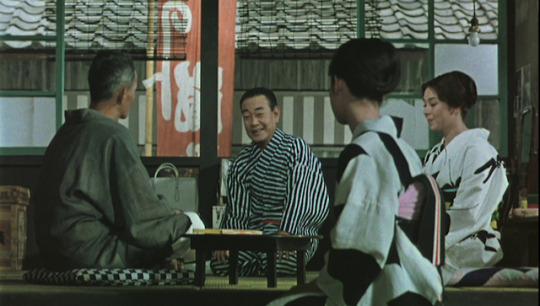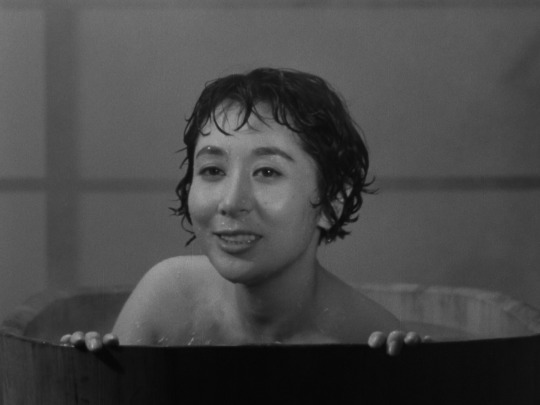#Takanobu Saitô
Photo

The Moon Has Risen (Tsuki wa noborinu), Kinuyo Tanaka (1955)
#Kinuyo Tanaka#Yasujirô Ozu#Ryôsuke Saitô#Chishû Ryû#Shûji Sano#Hisako Yamane#Yôko Sugi#Mie Kitahara#Kô Mishima#Shôji Yasui#Shigeyoshi Mine#Takanobu Saitô#Mitsuo Kondô#1955#woman director
40 notes
·
View notes
Photo

Floating Weeds (1959, Japan)
Director Yasujirô Ozu was tardy to synchronized sound in movies. With the introduction of sound in 1927, he did not make his first talkie until 1936. So too was he tardy with color. With black-and-white and color movies released together for decades, Ozu’s first color film came with Equinox Flower (1958), followed by Good Morning (1959; a remake of Ozu’s 1932 film I Was Born, But...). Later in 1959 another Ozu color talkie remake of one of his black-and-white silent films came to Japanese theaters: 1959′s Floating Weeds, a remake of A Story of Floating Weeds (1934). An already great original version is made better in this instance thanks to beautiful on-location shooting and a more mischievous sense of humor. In one of his most accessible pieces in his filmography, the cast includes many newer faces in this Ozu film. This is because Ozu’s contract with his home studio, Shochiku, had completed, and this next project was thanks to an invitation by Masaichi Nagata – the president of Daiei Film. Floating Weeds is made up largely of Daiei’s contracted actors, with one notable exception being Ozu mainstay Chishû Ryû.
Shot on the edge of the Kii Peninsula looking into Japan’s Inland Sea, Floating Weeds is a late-career testament to Ozu’s remarkable consistency as a director and storyteller, a crafter of dramas as compelling any drama could be – even when all the “showier” moments are never depicted, only discussed.
It is a sweltering summer in a lazy seaside town, with the occasional fishing vessel making its way through the harbor. A traveling kabuki troupe has arrived and they announce their new slate of shows with an impromptu parade and music. The troupe’s leader, Komajuro Arashi (Ganjirô Nakamura), is here not only to perform, but to see his old mistress, Oyoshi (Haruko Sugimura), and college-bound son, Kiyoshi (Hiroshi Kawaguchi). Oyoshi runs an intimate restaurant while Kiyoshi works at the local post office, building his savings before heading to university. Kiyoshi is told that Komajuro is his uncle – a secret that is threatened when Komajuro’s current mistress, Sumiko (Machiko Kyô), becomes jealous as he is not spending enough time with her during the daytime before performances. The film features a younger troupe actress named Kayo (Ayako Wakao) and the theater owner (Ryû). Character actors Kôji Mitsui and Haruo Tanaka also play bit roles.
The screenplay, co-written by Ozu and partner-in-crime Kôgo Noda, leans into the melodrama moreso than most Ozu films. Central to Floating Weeds are its characters speaking about permanence and belonging – like the original silent film version, the title is derived from the saying, “Floating weeds, drifting down the leisurely river of our lives.” For this film’s characters, it is difficult to always be traveling, living within the mercy of ticket sales, although the company of fellow troupe members makes the difficulty worth it. Komajuro is not an authoritarian boss to his fellow actors, but he is unable to see situations through others’ perspectives. Why are they not more like me, he wonders, as he is repeatedly surprised that the other members of his troupe imagine what life could be like without traveling across Japan. He cares for his fellow actors to the extent that everyone depends on each other for their roaming lifestyle. To his “nephew”, secrets remains unspoken behind an avuncular act that occurs every few years – Komajuro does not want Kiyoshi to follow or replicate a life that is dependent, rootless. It is how he remains Kiyoshi’s father, because he knows of no other way to do so. This concentration on Komajuro does come at the partial expense of understanding Oyoshi. It is no debate that she has been a wonderful mother to her son, but she is essentially a single parent that receives the occasional payment from an absent father. Does she harbor any spurned feelings for this arrangement? Is she content with what life has become or does she yearn for something else? Ozu and Noda never explore this quite enough.
Cinematic ellipsis is found in most of Ozu’s work, leaving the viewer to work together what has occurred in between scenes. Less-experienced Ozu viewers will be caught off-guard, claiming that characters seem to lack motivation, but Ozu has never been one to show the details of a steamy date, pomp and circumstance, or tearful departing words. As Ozu’s career progressed, his use of ellipsis generally increased – he became less interested in narrative flow, more interested in human perceptions and insights at a given moment. When Sumiko’s machinations involving Kayo are revealed to Komajuro and when Oyoshi tells her son about who his “uncle” is, all that has been built up to these dramatic reveals are moments of quiet or lightly reflective conversation. Melodrama here is empowered through objectively-shot conversation, oftentimes casual rumor-mongering or quotidian remarks about how the day has been. The static pillow shots in between scenes (Ozu’s innovation where, after a lengthy scene, he might show us a few seconds of the corner of a building or a shot of the sea’s edge or the neon lights of a narrow street to allow the viewer to reflect on what has just occurred) serve as periods do in writing. The idea of a scene may be picked up later, or maybe it has served its purpose in defining to the viewer the characters who gradually show who they are across the film (and in a handful of cases, minor characters who appear once or twice – to Ozu, even these characters have a significant role to the ideas the film expresses).
There are times where – other than the character names, the setting, the synchronized sound, and the color photography – Floating Weeds seems indistinguishable from A Story of Floating Weeds (the two films have similar opening pillow shots). By 1959, Ozu’s era of experimentation had long since concluded. Ironing out what became his signature style in the 1920s and 1930s, the tatami shot aesthetic (where the camera would be placed low to the ground, pointed slightly upwards) and the pillow shot became his trademarks. The ellipsis was a given (as was passable to terrible child dramatic acting, which Ozu never seemed to improve on – not as if children were essential to Ozu’s dramas). Differentiating between A Story of Floating Weeds and Floating Weeds is that the latter, mostly in its opening half, has a broader sense of humor, playfulness – one running joke, more easily understood by those familiar with Japanese filmmaking or culture at-large, is that this kabuki troupe is depicted as anything but a high-quality entourage. It is a welcome reprieve to what might otherwise have been a hard-hitting domestic drama with no easy resolutions. This might be because that Daiei Film was less associated with melodramas than Shochiku.
In his first Ozu film, cinematographer and Daiei contractee Kazuo Miyagawa (1950′s Rashômon, 1965′s Tokyo Olympiad) always keeps the camera static – as one would also expect from any Ozu feature. It is a beautifully shot movie, perhaps most notably for the following sequence. As Komajuro and Sumiko move in an argument that is carried across the street that separates them, the camera does not pan with them. Notice where the camera is located as the characters speak: not over anyone’s shoulder, but a set distance from each character as they make their points. The second way this is shot has the camera reverting back to showing us part of the rain-splattering street, far back enough so that neither character physically dominates the frame. This latter framing is an extraordinarily complex composition filled with vertical lines that almost threaten the frame’s geometry, but it serves to lend objectivity to the two characters arguing their views – so that cinematography does not have much say in giving unwanted sympathy to either character.
youtube
Composer Takanobu Saitô (1953′s Tokyo Story, Equinox Flower) usually had little of interest to do – musically, cinematically – in his scores for Ozu’s films. Flowing, pastoral string melodies without motifs are typically played over the opening credits. But this is, if only for one cue, an unusual score for Saitô. In the scene where the troupe enters town for the first time, Saitô has composed a cue where the melodies reside in the woodwinds and where percussion is prominent. It is carnival-like music, which may remind some Italian cinema aficionados of the exuberance of Nino Rota’s scores for ‘50s and ‘60s Fellini films.
Lacking the absolute serenity of many Ozu films, Floating Weeds is nevertheless an exemplar of Ozu’s inimitable style and how emotionally and philosophically effective it can be. Because it has more above-the-surface melodrama than most in Ozu’s filmography, Floating Weeds is a possible starting point for any neophytes to a type of filmmaking far removed from exposition-delivering and overt dramatics of mainstream Western cinema (not that all Japanese cinema has bucked Western influences – a vast majority of the most popular contemporary Japanese movies, live-action and animated, take notes from Hollywood and not Ozu). For those who make Floating Weeds their first or one of their first Ozu films, the film serves as an introduction to some of the unifying ideas in his entire filmography. Individual lives are inescapably altered by others. To repudiate or fail to intuit that truth is to invite suffering; to intuit that truth but not attempt to understand others’ actions is hubris.
My rating: 9/10
^ Based on my personal imdb rating. My interpretation of that ratings system can be found here.
#Floating Weeds#Yasujiro Ozu#Ganjiro Nakamura#Machiko Kyo#Ayako Wakao#Hiroshi Kawaguchi#Haruko Sugimura#Hitomi Nozoe#Chishu Ryu#Kogo Noda#Kazuo Miyagawa#Takanobu Saito#TCM#My Movie Odyssey
6 notes
·
View notes
Text
[Last Film I Watch] Tokyo Story (1953)
English Title: Tokyo Story
Original Title: Tôkyô monogatari
Year: 1953
Country: Japan
Language: Japanese, English
Genre: Drama
Director: Yasujirô Ozu
Writers:
Yasujirô Ozu
Kôgo Noda
Music: Takanobu Saitô
Cinematography: Yûharu Atsuta
Cast:
Chishû Ryû
Chieko Higashiyama
Setsuko Hara
Haruko Sugimura
Sô Yamamura
Kuniko Miyake
Kyôko Kagawa
Shirô Ôsaka
Nobuo Nakamura
Eijirô Tôno
Hisao Toake
Teruko…
View On WordPress
#9.1/10#Black & White#Chieko Higashiyama#Chishû Ryû#Eijirô Tôno#Haruko Sugimura#Hisao Toake#Japanese Film#Kuniko Miyake#Kyôko Kagawa#Nobuo Nakamura#Sô Yamamura#Setsuko Hara#Shirô Ôsaka#Teruko Nagaoka#Yasujirô Ozu
0 notes
Photo

Forever a Woman (Chibusa yo eien nare), Kinuyo Tanaka (1955)
#Kinuyo Tanaka#Sumie Tanaka#Yumeji Tsukioka#Ryôji Hayama#Junkichi Orimoto#Hiroko Kawasaki#Shirô Ôsaka#Tôru Abe#Masayuki Mori#Kumenobu Fujioka#Takanobu Saitô#1955#woman director
27 notes
·
View notes